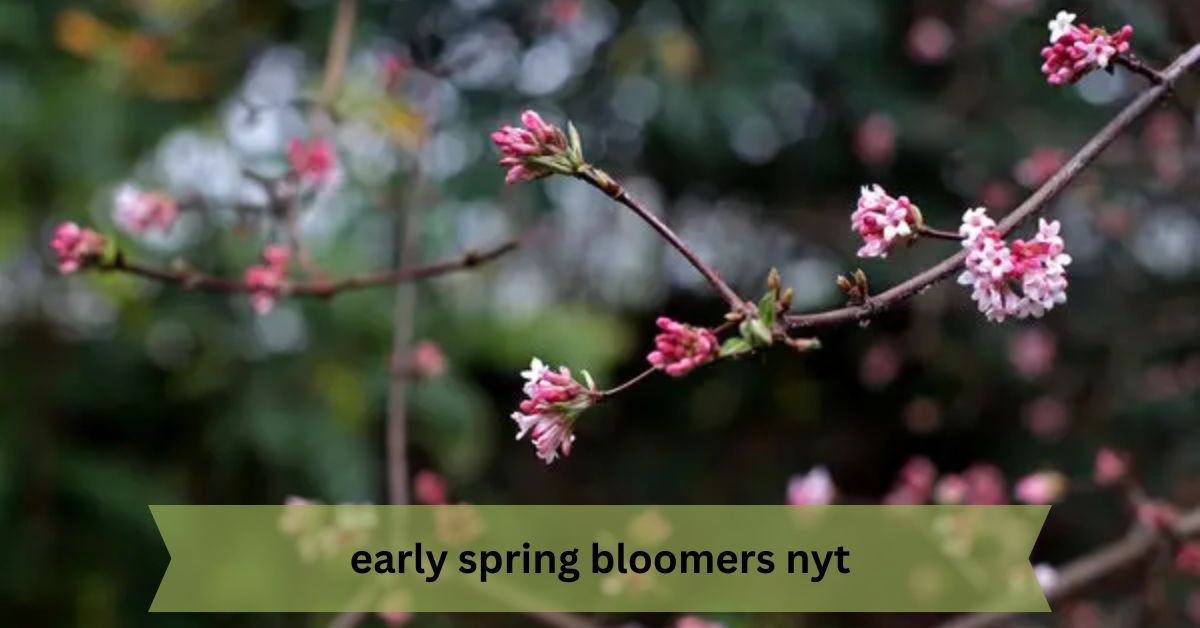This article delves into the importance of early spring bloomers nyt, focusing on their significance in both nature and crossword puzzles, with insights that go beyond basic information to help readers truly appreciate the wonders of spring.
What are Early Spring Bloomers NYT?
Early spring bloomers are the first flowers to emerge after winter, braving the last cold snaps to bring life and color back into gardens. These flowers typically begin blooming between late February and early March, depending on the climate.
They’re often hardy perennials, meaning they return year after year, giving nature lovers something to look forward to as winter fades.
Examples of Early Spring Bloomers NYT
- Crocus (Croci) – Known as one of the earliest bloomers, Croci are small, bright flowers that burst through the snow in shades of purple, yellow, and white.
- Daffodils – Another classic early bloomer, daffodils are bright yellow flowers that symbolize renewal and fresh beginnings.
- Snowdrops – True to their name, snowdrops are often seen peeking through the snow, providing hope that warmer days are just around the corner.
- Hellebores – Sometimes called the “Christmas Rose,” these hardy plants bloom even in the coldest weather, often around late winter or early spring.
- Primroses – Known for their vibrant colors, primroses add pops of pink, yellow, and purple to gardens in early spring.
These early bloomers are essential for kickstarting the growing season, providing nectar for bees and other pollinators just as they emerge from winter dormancy.
Early Spring Bloomers in The New York Times Crossword
For puzzle enthusiasts, the phrase “early spring bloomers” frequently appears in the New York Times crossword, with the answer being Croci. The NYT crossword is known for its clever clues, and this is one of the many references to springtime and nature.
Crossword puzzles often use abbreviated or plural forms of common words, which is why Croci (the plural of crocus) is the answer instead of the singular “crocus.” Recognizing this pattern can help solvers tackle more challenging puzzles, especially those with themes related to seasons, flowers, and nature.
Other Common Spring-Related Crossword Clues
- “Bird symbolizing the start of spring” – Answer: Robin
Robins are one of the first birds to appear in spring, often associated with the season’s arrival. - “Printed piece of punditry” – Answer: Op-Ed
While not directly related to nature, this clue frequently appears in NYT crosswords and relates to opinion pieces typically found in newspapers like The New York Times.
The Importance of Early Spring Bloomers for Ecosystems
Early spring bloomers are more than just a signal that winter is ending—they play a crucial role in ecosystems. These flowers provide an essential source of food for pollinators such as bees and butterflies, which emerge from hibernation or migrate back to cooler regions during this time.
Pollination and Ecosystem Support
As early bloomers open their petals, they offer nectar and pollen to early-foraging insects. This jump-starts the pollination process, which is vital for the reproductive cycles of many plants. Early pollination helps ensure that fruits and seeds are available for wildlife later in the year.
Without early bloomers, many pollinators would struggle to find food after winter, potentially disrupting the ecosystem’s balance.
Gardening with Early Spring Bloomers
Planting early spring bloomers can help any garden become a haven for wildlife, especially during the transitional months between winter and spring. Here’s a guide to incorporating these flowers into your garden.
Choosing the Right Flowers
To create a vibrant spring garden, consider planting a mix of the following early bloomers:
- Crocus (Croci): Plant crocus bulbs in the fall to ensure they’re among the first flowers to bloom in spring. These flowers prefer well-drained soil and sunny spots.
- Daffodils: Daffodil bulbs are easy to plant and require little maintenance. They do best in sunny or partially shaded areas and come back year after year.
- Snowdrops: Ideal for colder climates, snowdrops thrive in shaded areas and can even bloom while there’s still snow on the ground.
- Primroses: Known for their wide range of colors, primroses are great for adding variety to early spring gardens. They prefer cool, moist soil.
- Hellebores: For winter color, plant hellebores in well-drained soil under trees or in partial shade. They’re low-maintenance and long-lasting.
Planting Tips for Early Bloomers
- Timing: Most early bloomers need to be planted in the fall to establish strong root systems before winter. Be sure to plant bulbs before the first frost for the best results.
- Soil Preparation: Prepare the soil by mixing in compost or organic matter to improve drainage and fertility. Many early bloomers prefer slightly sandy or well-drained soil.
- Watering: While early bloomers don’t need much care, they do require consistent watering as they establish themselves. Be sure not to overwater, as this can cause bulbs to rot.
- Layering: For a continuous display of flowers, layer bulbs of different types at varying depths. For example, plant daffodils deeper than crocuses, so they bloom in succession.
The Cultural Significance of Early Spring Bloomers
Early spring bloomers have long been associated with new beginnings and hope. They’ve been celebrated in art, literature, and even crossword puzzles like those found in the NYT.
Spring in Literature and Art
Springtime, and the flowers that come with it, have inspired countless works of literature and art. From Shakespeare’s sonnets to Impressionist paintings, early spring bloomers like crocuses, daffodils, and snowdrops often symbolize renewal and beauty.
One of the most famous literary references to early bloomers comes from William Wordsworth’s poem “I Wandered Lonely as a Cloud,” where he describes daffodils as a “host, of golden daffodils; beside the lake, beneath the trees, fluttering and dancing in the breeze.”
Early Spring Bloomers in Popular Culture
In modern times, early spring bloomers continue to hold a special place in pop culture. They appear in movies, TV shows, and even crossword puzzles like those found in The New York Times.
Crossword enthusiasts enjoy finding clues related to spring, nature, and gardening, with answers like Croci and Robin being frequent favorites.
Frequently Asked Questions
1. What are early spring bloomers in The New York Times crossword?
In the context of the NYT crossword, early spring bloomers often refer to Croci, the plural form of crocus. These flowers are among the first to bloom in spring, making them a popular crossword answer.
2. Why are early spring bloomers important?
Early spring bloomers are crucial for ecosystems, providing food for pollinators like bees and butterflies that emerge from hibernation. They also help kickstart the growing season for plants and wildlife.
3. What is the significance of the crocus in spring?
The crocus is one of the first flowers to bloom after winter, symbolizing new beginnings and the arrival of warmer weather. Its early appearance makes it a popular flower in gardening and crosswords alike.
4. How do I plant early spring bloomers in my garden?
Plant early spring bloomers like crocus, daffodils, and snowdrops in the fall, before the first frost. Choose well-drained soil and sunny locations, and water them consistently until they’re established.
5. What birds symbolize the arrival of spring?
In crossword puzzles and popular culture, the Robin is often used to symbolize the start of spring, as these birds are one of the first to appear when the season changes.
Early spring bloomers, whether in nature or in crosswords like those from the NYT, bring excitement and a sense of renewal. Their beauty and resilience make them essential symbols of spring, providing not only visual delight but also essential support for ecosystems and pollinators.



